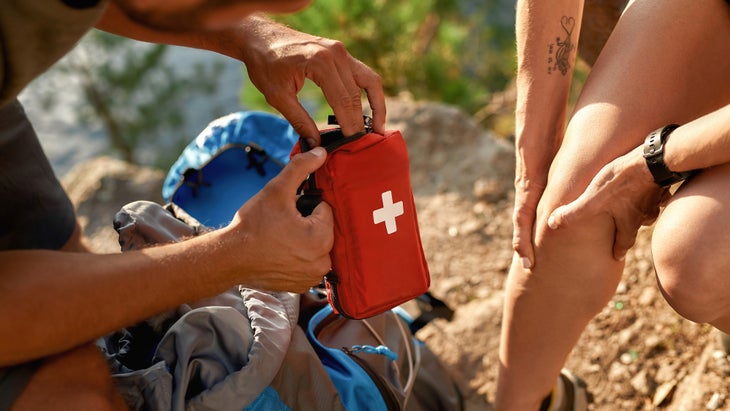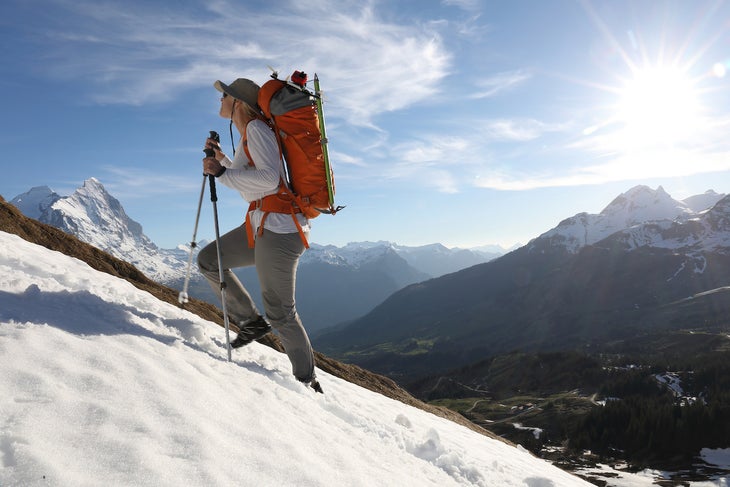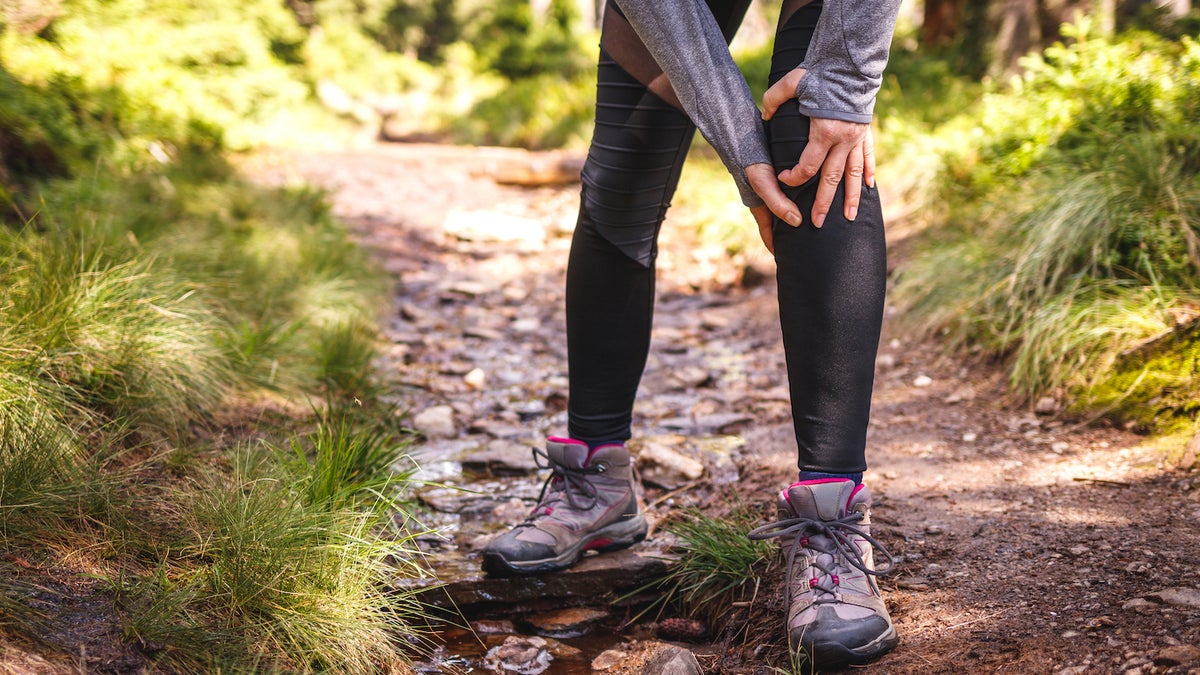Products You May Like
Get access to everything we publish when you
sign up for Outside+.
Knee pain is a common hiking ailment; a weight-bearing hinge joint is not a structurally ideal setup for hiking. Walking at an incline puts two to three times your body weight of pressure on your knees, according to Harvard Medical School, and walking at a decline adds even more pressure.
The little decisions you make can have big consequences in your hiking health. A too-heavy pack adds pressure to your knees and joints. Poorly fitting shoes can give you blisters and even make you change the way you naturally walk, which increases your risk for injury. Also, choosing to go sans trekking pole means your knees are absorbing a lot of unnecessary weight (poles distribute weight more evenly throughout the body). None of this means you should hang up your hiking shoes for good if you start to feel knee pain. Just be smart about how you manage it.
Preventing Knee Pain Before it Happens
You’ll extend your hiking years if you treat potential injuries at the first twinge of pain, says Belinda Brownell, a Colorado-based physical therapist who’s been treating hikers for more than 20 years. It’s important to listen to the cues your body is sending you both on and off trail. Once your knees start feeling creaky, don’t ignore it. Be proactive before you hit the trail by establishing a strength training regimen that targets the quads, hamstrings, glutes, and calves—all are muscles that support and protect your knees. Preventing and treating little pains is much easier than recovering from full-blown knee surgery.
Here are some exercises you can do at home every day to strengthen the muscles that protect your knee.
- Wall sit: Strengthen your quads by standing against the wall with your knees bent. Hold this position for 30 seconds followed by a 30-second rest for four to five sets.
- Banded monster walk: Wrap a resistance band around your ankles and step laterally while holding a slight squat. Move for the same distance in both directions in order to correctly strengthen both sides of your body. The resistance band should provide enough tension that walking laterally is a challenge.
- Hip raises: Lay on your back with your arms resting beside you. Lift your hips to the ceiling as you squeeze your glutes. If this is too easy, hold a weight or barbell to your hips or wear a resistance band above your knees. Three sets of 10 hip raises will strengthen your glutes and help keep your knees stable on the trail.
Why Women Should Focus on Strength Training
Genetically, women are at higher risk to injury and should prioritize strength training to minimize that risk. Compared to men, they have lower amounts of testosterone, a hormone that contributes to muscle density. Women also have less muscle mass around their knees than men do, says Samantha Smith, a sports medicine specialist at Yale Medicine. Throughout the month, women’s estrogen levels fluctuate, which affects their bone strength and the flexibility of their tendons and ligaments. Also, women have wider pelvises than men do. Because this wide bone structure affects how the thigh bone, tibia, and femur interact, with every step, women’s knees are placed under more pressure than men’s knees are. Strength training is a way to overcome genetic hurdles and continue hiking pain-free.

What Different Kinds of Knee Pain Mean
If you feel a persistent ache under the kneecap, your knee might not be tracking properly or the cartilage might be worn down. Hiking downhill can irritate your knee and its surrounding cartilage. Try moving in small zigzags—it’s easier on your joints than hiking straight down. Also, don’t lock your knees while walking downhill. Pain relief could be as simple as getting shoe insoles and strengthening and stretching the muscles around the knee, but it’s best to let a doctor decide which approach is best for you. If pain sets in midtrip, apply a cold pack or snow and take ibuprofen.
If you feel a sharp, shooting pain above or below the knee while hiking, it’s most likely tendinitis, an inflamed tendon caused by overuse. Brownell says a sudden increase in hiking mileage is the most common cause, followed by tight hamstrings and weak quadriceps. At the first sign of pain, ice the area and rest. If the pain isn’t gone after a few days off, see your doctor. On the trail, take an anti-inflammatory, dunk your knee in a cold stream during breaks, and lighten your load by asking your hiking partner to carry the tent.
If you feel pain around the entire knee area after a fall, you might have torn the anterior cruciate ligament (ACL), the knee’s main stabilizer. This injury is more common in sports such as basketball or tennis, but a fall that twists or hyperextends the knee can tear your ACL, too. A telltale sign is the knee buckling when you try to stand. Walk out using trekking poles as crutches, keeping the knee bent, and placing weight on your toes. Don’t wrap the knee as it could increase the swelling, says Brownell. Head to the doctor’s office from the trailhead.

Why Your Knees Hurt More on Hills
Knee pain in general isn’t always an indication of injury. It could be just because you were sitting in a weird position that ended up putting more pressure on your joints. But, if you’re already feeling pain, hilly hiking could add pressure to your joints and leave you whimpering. While moving up and down hills, we bend our knees more than we would while moving on flat ground, so this works our muscles more.
Downhill Pain
It doesn’t take a physical therapist to notice that it’s easier to hike downhill than uphill. But form is still crucial here: Your body hits the ground harder and your posture is different while moving downhill, so if you have bad form, you’re only hiking toward injury faster. That means you should fight against the urge to lock your knees or lean back. Keep your knees slightly bent at all times and try to stand straight, even leaning slightly forward at times. Using trekking poles is a good way to keep decent form and reduce the amount of compressive force placed on your joints.
If you’re training for a hike with big elevation loss, research shows that you should train your muscles for downhill hiking too. Even just five minutes of downhill hiking strengthens those muscles and reduces your chance for injury more than level-ground walking does. It’s important to train for downhill hiking, but don’t overdo it. Just a couple minutes will strengthen your muscles without damaging them.
Uphill Pain
Even though hiking uphill doesn’t exert as much joint pressure as hiking downhill, it still asks a lot of your joints. You’re moving against gravity—and sometimes with a heavy pack on. This means that proper form is essential to staying injury-free. It’s natural to want to lean toward the hill as you ascend, but if you do this, make sure you’re not hinging from the hip. Leaning too far forward or backward throws off your balance and could also lead to injury. You should be only slightly leaning forward and from the ankles. Using correct form means you’re engaging the correct muscles around your knee, the muscles that you strength trained and prepared for the hill, and not straining any weaker muscles.

How to Pick Hiking Footwear to Avoid Knee Pain
Both on and off the trail, it’s important to buy shoes that actually fit correctly. Sometimes the shiny colorful shoes that catch your eye aren’t the most comfortable, supportive shoes for your feet. Don’t buy based on aesthetics; buy based on feel. Retailers, such as REI, will help fit you to your new hiking boots. Be sure to bring hiking socks with you when you try them on to get the most accurate feel.
Breaking Down Boot Construction
There are several elements of hiking boots that you could consider when purchasing a new pair, but the two biggest ones are support and fit. There should be enough cushion in your boot so that when you strike the ground, your boots absorb some of the impact and reduces the stress that would go to your knees. If the lug pattern—the rugged rubber on the bottom of the foot that provides traction—looks worn down, then your boots likely aren’t supporting you or your knees enough. Enough traction also means you are less likely to have a fall that injures your knee.
The best boot you can buy is the boot that fits. Boots that don’t fit correctly will likely result in joint or ligament pain, so it’s important to make sure your boots support your whole foot. Your toes shouldn’t feel crowded or swim around in a spacious toe box. Pay attention to the arch as well With every step, hiking boots bend at the ball of your foot, and so the arch of your foot should match the arch on your boot. Anything that affects your natural gait or correct hiking form could put you at risk of injury.
Lacing Up Correctly
You’ll be more comfortable on the trail if you take the time to break in your boots beforehand. If you start noticing pain or hot spots while breaking in your boots, then you can lace up to adjust how your feet fit in your boots. This is helpful for injury prevention: If your feet are uncomfortable while hiking, then you might compensate for it in how you walk, which could lead to injury or pain somewhere else. Boot lacing patterns can prevent black toenails, blisters, and other annoying hiking ailments as well. There are many ways to lace up your boots, but each technique serves a different purpose. Some of the most popular techniques include the surgeon’s knot, window lacing (or box lacing), and toe-relief lacing.
Note: If you replace your boot laces, get new ones with the same shape (circle, oval, flat) and length of the previous kind.
Protecting Your Joints with Insoles
Over time, your shoe can become packed out. This means that the shoe’s midsole has compressed and flattened with use, so it isn’t reducing the amount of pressure your joints get with each step. Whether or not the outsole on your shoe is still solid, a packed-out midsole is a good sign that it’s time to start shopping for a new pair.
Insoles can put your feet into the correct alignment for standing, walking, and hiking. According to Mercy Health, you should get insoles if you’re on your feet for more than five hours at a time or if you have flat feet or high arches. The insoles already in your boots are not one-size-fits-all, and your feet have a specific contour that you should protect in order to prevent both joint problems as well as plantar fasciitis and other lower-body injuries.
